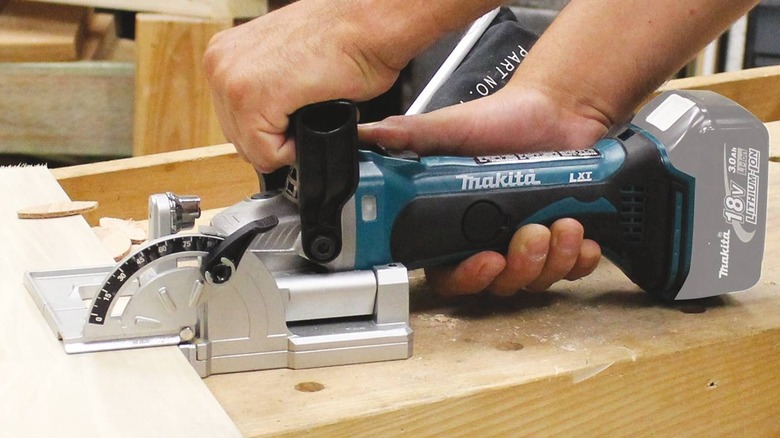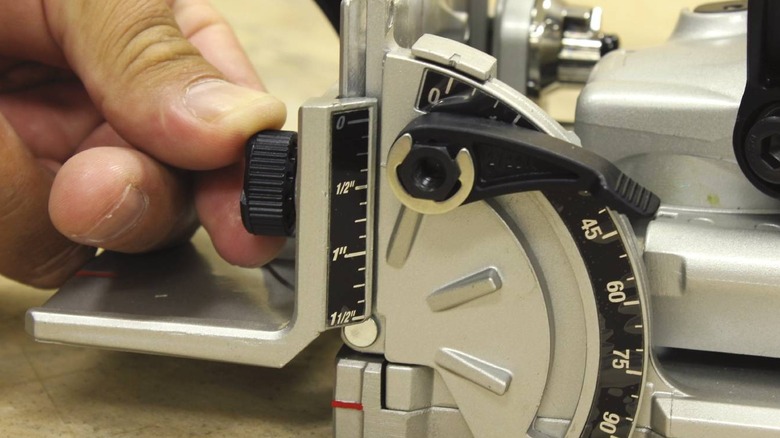Makita's Biscuit Joiner: What It Is & What It's Used For
Most hand tools have names that accurately convey their appearance and purpose. A claw hammer is a hammer with a claw on it, a tape measure is a piece of tape that measures things, and so on. However, there are some tools that, for one reason or another, have earned themselves a somewhat untraditional moniker, one that might not immediately explain what it's supposed to be used for. A good example is the biscuit joiner.
If someone told you they were running out to buy a biscuit joiner, you'd probably assume they were getting something for making baked goods. In actuality, a biscuit joiner is an important tool for advanced woodworking. Several major hardware brands sell their own biscuit joiners, including Makita, which has a long history of selling quality tools. If you don't already know what a biscuit joiner is used for, though, that probably doesn't mean anything to you. So, what exactly is a biscuit joiner, and what does Makita's biscuit joiner in particular have going for it?
What is a biscuit joiner and how does it work?
A biscuit joiner is a powered woodworking tool designed to aid in attaching two pieces of wood together. Have you ever tried to glue a big piece of wood to another and found that it's rigid and unstable? That's because a glob of glue only creates a single point of connection. A biscuit joiner is meant to alleviate this by creating firm, yet flexible joints in wooden surfaces, connected via small wooden pucks called biscuits. A biscuit is made of compressed wood, which swells inside when exposed to water. By sticking a biscuit into a slot, then applying water-based glue, it expands in size to fill the spot, creating a locking joint.
The biscuit joiner's job is to cut the initial notches that a biscuit is placed into on two pieces of wood. By pressing the front of the joiner into the side of a piece of wood, a small blade hidden within cuts out a perfectly-sized slot for a biscuit to go into. If you cut these notches into two pieces of wood, then insert the biscuit into one of them, you can connect the other piece to the first by pushing it into the other side of the biscuit.
What do you use a biscuit joiner for?
A biscuit joiner is something of a secret weapon for woodworkers. It allows you to create perfectly aligned, easy-to-assemble wooden components with a fraction of the effort such a thing would normally require. While a biscuit isn't quite strong enough for industrial level woodworking, such as the assembly of an outdoor fence, wooden projects for the inside of your home can definitely be made more manageable with a biscuit joiner.
Practical applications for a biscuit joiner include creating sturdy mitered corners for the sides of a wooden box, joining small lengths of wood together to create a picture frame, and creating dividers for a wooden shelf. Just about any kind of light-duty woodworking project can benefit from having a biscuit joiner around, especially something like building a cabinet or furniture. In fact, if you have wooden furniture that's been damaged somehow, you may be able to use a biscuit joiner to repair it, filling the gaps in any damaged joints with expanded biscuits.
Makita's biscuit joiner is great for various woodworking applications
Now that you know what a biscuit joiner is for, you might be thinking of picking one up yourself for your next bout of home woodworking. If you're in the market, Makita's 18V LXT cordless biscuit joiner is definitely a tool you'll want to have for your next DIY carpentry project. Technically, the tool is called a "plate joiner," but it's the same thing.
Rather than a traditional power cord, Makita's biscuit joiner draws energy from one of the brand's 18V battery packs. On a full charge, the tool can deliver up to 300 cuts before needing a fresh pack. The size of cut you want is set via the tool's adjustable plates, which feature six depth settings with one-touch stops to eliminate the guesswork. These cuts can be sized for just about any common biscuit size, including #0, #10, #20, and more. The built-in pivot fence also allows you to tilt the angle of your cut up to 90 degrees, which is great for creating mitered corners.
If you're looking to create some quality joints in your latest woodworking pursuit, you'd do well to have a biscuit joiner on standby, and as far as biscuit joiners go, Makita's is a viable choice.



